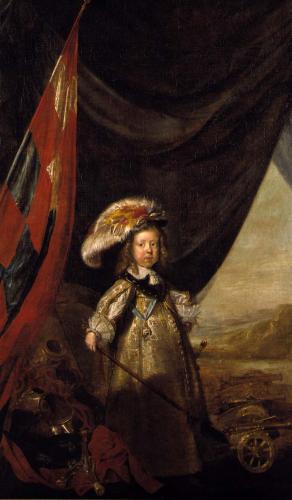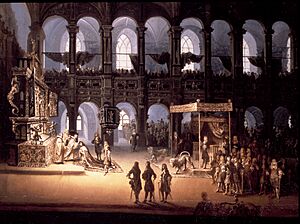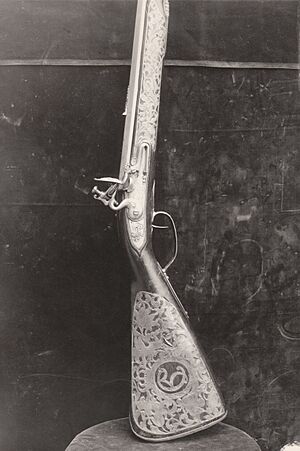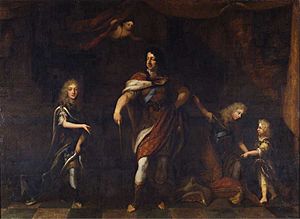Christian V of Denmark facts for kids
Quick facts for kids Christian V |
|
|---|---|
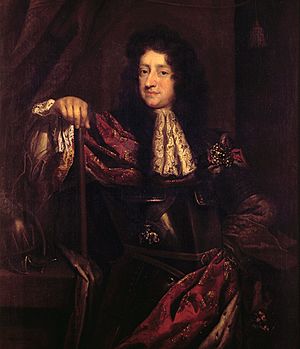
Portrait by Jacob d'Agar, c. 1685. The king poses with his hand authoritatively placed on the marshal's baton, as a true absolute monarch.
|
|
| King of Denmark and Norway (more...) | |
| Reign | 9 February 1670 – 25 August 1699 |
| Coronation | 7 June 1671 Frederiksborg Palace Chapel |
| Predecessor | Frederick III |
| Successor | Frederick IV |
| Grand Chancellors |
See list
Peder Griffenfeld
Frederik Ahlefeldt |
| Born | 15 April 1646 Duborg Castle, Flensburg |
| Died | 25 August 1699 (aged 53) Copenhagen, Denmark |
| Burial | Roskilde Cathedral |
| Spouse |
Charlotte Amalie of Hesse-Kassel
(m. 1667) |
| Issue among others... |
Frederick IV of Denmark Prince Christian Princess Sophia Hedwig Prince Charles Prince William |
| House | Oldenburg |
| Father | Frederick III of Denmark |
| Mother | Sophie Amalie of Brunswick-Lüneburg |
| Religion | Lutheran |
Christian V was the King of Denmark and Norway from 1670 until he passed away in 1699. He was born on April 15, 1646, and died on August 25, 1699. People generally liked him, especially the common folk. He was the first king to be crowned at Frederiksborg Castle as an absolute monarch. This meant he had complete power, following a new law in Denmark-Norway.
Christian V made the king's power even stronger. He allowed people who were not nobles from Holstein, Denmark, or Norway to work in the government. This helped him control the powerful noble families. As king, he wanted to show his power through grand buildings. He even dreamed of a Danish Versailles, like the famous palace in France. He was also the first to use the special Throne Chair of Denmark in 1671, which was partly made for this purpose. His motto was: Pietate et Justitia, which means "With piety and justice."
Contents
Christian V: King of Denmark and Norway
Early Life and Becoming King
Prince Christian was born on April 15, 1646, at Duborg Castle in Flensburg. At that time, Flensburg was part of the Duchy of Schleswig. He was the first son of Prince Frederick of Denmark and his wife, Sophie Amalie of Brunswick-Calenberg. Prince Frederick was a younger son of King Christian IV. However, his older brother, Christian, passed away in 1647. This meant Frederick could become the next king.
After King Christian IV died in 1648, Frederick became King Frederick III of Denmark and Norway. Prince Christian was chosen to be his father's successor in June 1650. This was not a free choice, but more like an automatic passing down of the throne. Christian went on a long trip to Holland, England, and France. He saw how powerful kings like Louis XIV of France were. He also learned about the idea of the divine right of kings, which said kings got their power directly from God.
He came back to Denmark in August 1663. From 1664, he was allowed to join meetings of the State College. In 1665, a law called the Royal Law made it official that the throne would be passed down in the family. Christian was welcomed as the future king in Copenhagen in 1665. He was also welcomed in other cities like Odense, Viborg, and Christiania (now Oslo) in Norway. Just before he became king, he joined the Council of the Realm and the Supreme Court.
Becoming King of Denmark and Norway
On February 9, 1670, King Frederick III died at age 60. Christian immediately became the King of Denmark and Norway. He was only 24 years old. He was the second absolute monarch of Denmark-Norway.
He had a formal coronation ceremony on June 7, 1671. This took place in the chapel of Frederiksborg Palace. After this, Frederiksborg Palace became the usual place for Danish kings to be crowned. Christian was the first king whose right to rule was passed down through his family. To celebrate this, Denmark-Norway got new, expensive crown jewels and a beautiful ceremonial sword.
Christian V's Reign
Christian V was known for being brave and friendly. This made him popular with ordinary people. However, his image was hurt by a war he started to get back Scania from Sweden. This war was called the Scanian War. It used up a lot of Denmark's money and didn't gain any land.
Christian allowed common people from Denmark and Norway to work in the government. This was part of his plan to reduce the power of the nobles. To do this, he created new noble titles like count and baron. One person he promoted was Peder Griffenfeld. Christian V made him a Count in 1670 and a high government official in 1674.
Peder Griffenfeld was a very smart politician. He understood that attacking Sweden was risky because Sweden was allied with France, a very powerful country. But Christian V decided to start the Scanian War (1675-1679) anyway. He wanted to take back Scania, which Denmark had lost in 1658.
As Griffenfeld had warned, France, Sweden's strong ally, ended up deciding the peace terms. Even though Denmark won battles at sea, Denmark's hopes for changing borders with Sweden were crushed. The war was bad for Denmark-Norway's economy and didn't achieve its goals. By this time, Christian V no longer had Griffenfeld's advice. In 1676, Christian was convinced to put Griffenfeld in prison for the rest of his life.
After the Scanian War, Christian's sister, Princess Ulrike Eleonora of Denmark, married the Swedish king, Charles XI. Even with these family ties, war almost broke out again in 1689. Charles XI supported the exiled Christian Albert, Duke of Holstein-Gottorp, who claimed land in Schleswig-Holstein.
Christian V only spoke German and Danish. Because of this, some people thought he wasn't well-educated. He couldn't easily talk to foreign diplomats. People also thought he relied a lot on his advisors. In his own writings, Christian V said his main interests were "hunting, war and maritime affairs."
Christian V made important new laws. He introduced the Danish Code (Danske Lov) in 1683. This was the first set of laws for all of Denmark. He also introduced the similar Norske Lov (Norwegian Code) in 1687 for Norway. He also created a land register in 1688. This was a record of land values to help create fairer taxes.
During Christian V's rule, Denmark's trade grew. The trade of cattle, which had suffered from fires and wars, got much better. Thousands of cattle were moved through Jutland on the Oxen Way. These cattle were fattened in the Danish King's German area, County of Oldenburg. Then they went to a big market in Wedel and were sold across North Germany. As the population grew, the demand for beef, grains, and fish increased. By 1680, about 40,000 cattle were sold at each market. Denmark earned a lot of money from exporting farm products, especially cattle, to Germany and the Netherlands.
During his reign, science also had a great period. This was thanks to the work of the astronomer Ole Rømer. This happened even though the king himself wasn't very interested in science. Christian V died from problems after a hunting accident. He was buried in Roskilde Cathedral.
Family Life
Christian V had eight children with his wife, Charlotte Amalie of Hesse-Kassel. He also had six children with his mistress, Sophie Amalie Moth (1654–1719). Sophie was the daughter of his old teacher. Christian introduced Sophie to the court in 1672, which upset his wife. He made Sophie the Countess of Samsø in 1677.
Here are his children with Queen Charlotte Amalie:
| Name | Birth | Death |
|---|---|---|
| Frederick IV | 2 October 1671 | 12 October 1730 |
| Christian Vilhelm | 1 December 1672 | 25 January 1673 |
| Christian | 25 March 1675 | 27 June 1695 |
| Sophie Hedevig | 28 August 1677 | 13 March 1735 |
| Christiane Charlotte | 18 January 1679 | 24 August 1689 |
| Charles | 26 October 1680 | 8 June 1729 |
| Daughter | 17 July 1683 | 17 July 1683 |
| Vilhelm | 21 February 1687 | 23 November 1705 |
Here are his children with Sophie Amalie Moth:
| Name | Birth | Death |
|---|---|---|
| Christiane Gyldenløve | 7 July 1672 | 12 September 1689 |
| Christian Gyldenløve | 28 February 1674 | 16 July 1703 |
| Sophie Christiane Gyldenløve | 1675 | 18 August 1684 |
| Anna Christiane Gyldenløve | 1676 | 11 August 1689 |
| Ulrik Christian Gyldenløve | 24 June 1678 | 8 December 1719 |
| Daughter | 1682 | 8 July 1684 |
Images for kids
See also
 In Spanish: Cristián V de Dinamarca para niños
In Spanish: Cristián V de Dinamarca para niños


